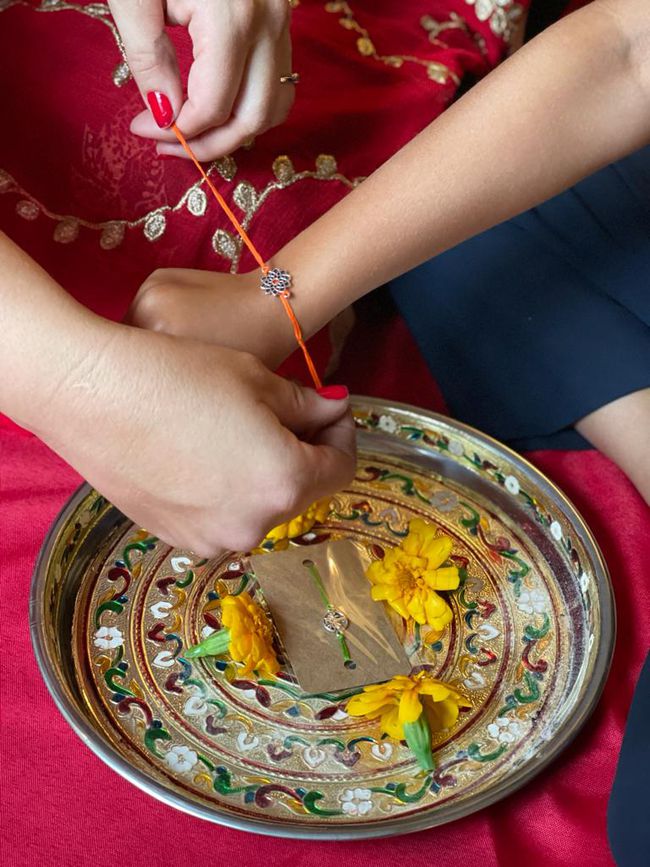Raksha Bandhan, or Rakshabandhan, is a centuries-old Hindu tradition celebrating love, gratitude, unity, and a promise of protection.
The word "Raksha" means protection and "Bandhan" means bond. A sacred thread called a "Rakhi," symbolizing positivity and good wishes, is tied on the wrist of a loved one in a ceremony filled with laughter, sweets, and joy.
Raksha Bandhan falls on a full moon day in Shravan, the fifth month of the Hindu lunar calendar. This year it's celebrated on August 22.
The holiday is most popular as a celebration of brother-sister bond. Traditionally, a sister prepares a Puja Thali—a prayer plate filled with flowers, a diya (oil lamp), sacred red powder, sweets, and rakhi. But historical and religious references highlight the holiday as an act of tying a sacred thread to express love and receive protection beyond the brother-sister relationship. For example, Alexander the Great's wife sent a rakhi to the King Porus asking to spare her husband's life. In the Hindu epic Mahabharata, Draupadi tied a rakhi on Lord Krishna—one of the incarnations of Lord Vishnu from the Holy Trinity—who in turn helped Draupadi in several instances when she needed it the most.

How to Celebrate Raksha Bandhan with Your Kids
Having spent our childhood in India, my sister and I enjoyed Rakshabandhan with our cousins, aunts, friends, and neighbors. Our family honored the love and the sentiment of the holiday. I remember buying the trendiest rakhi's for my cousins, friends, and Lord Krishna—the latter is something many young girls do to express their love and to ask for protection in time of need.
As an immigrant mom raising a child in America, it's important to make sure my 4-and-a-half-year-old son understands his parent's roots and embraces his identity. And with everything that we have been through as families and society during the pandemic, I look forward to Raksha Bandhan where we can celebrate bonds and friendships and express our gratitude for our loved ones.
Here are some easy DIY activities to get you started on planning your celebrations.
Make your own rakhi
All you need for this bracelet filled with love are some craft beads, thread, and scissors. Take a thread or craft floss and cut it to an appropriate length so a child can tie it as a bracelet. Knot one end and place beads on the string and then tie a knot at the other end. Leave enough room so you can tie a knot around the wrist too. Get creative with colors, letters, and designs.
It is also customary for the person tying the rakhi to receive gifts from the person they give it to. We would get new clothes, cash, candy, and toys—my most favorite part of the holiday. It was like Christmas in summer.

Create a gratitude craft
Make a gratitude flower where a child can write what they’re most grateful for about their rakhi friend on each flower petal. Turn it into a rakhi gift which they can exchange with one another. Encourage your kid to also read it out loud to their friend. (Here is a link to a gratitude flower pattern you can print and cut out for the activity.)
Try a delicious Mango Lassi
No Raksha Bandhan celebration is complete without sweets. In the hot summer months, enjoy this Indian Mango Lassi recipe to cool off and to transport you to the mango orchards of India.
You will need yogurt, ice cubes, mangoes or mango pulp, sugar, and powdered cardamom (optional).
- Add a cup of yogurt, a few ice cubes, a cup of mangoes or mango pulp, and 1 tablespoon of sugar in a blender
- Blend till it's the consistency of a smoothie
- If it's too thick, add a few tablespoons of milk to thin it out
- Check for sweetness and add more sugar if needed
- Sprinkle with a pinch of cardamom powder and enjoy a cold Mango Lassi
Host a rakhi party
For Rakshabandhan at my house, we typically invite our family and friends of all backgrounds over for a gratitude party. Kids make their own rakhis, pick who they wish to tie theirs on, eat mithai (Indian sweets), and exchange small gifts. This has not only helped retain the essence of the holiday and pass it down to our son, but also expanded our family by sharing with loved ones of all backgrounds. During the pandemic, you can host a smaller gathering outdoors or even virtually—either way, the meaning of the holiday won't be lost.
